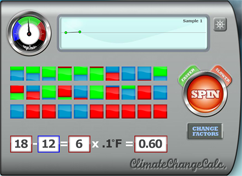Here are some definitions to help you in your investigation.
Weather - the short-term condition of the atmosphere
Condition - the physical state of something
Atmosphere - the air that surrounds Earth’s surface
Temperature - the hotness or coldness of the environment
Fahrenheit -a unit of measure of temperature
Temperature Change - the final temperature minus the initial temperature
Prediction - a statement about what will happen in the future
Average - a single number used to represent a set of numbers
Air Pressure - the force of air pressing down over a given area
Wind Speed - how fast the wind is moving
Rainfall - the amount of rain that falls over a given area in a certain amount of time
Humidity - the amount of water vapor in the air
Solar Radiation - the power of the Sun per unit area
Climate - the aggregate of the long-term weather for a given area
Aggregate - a whole formed by a collection of parts
What is weather?
Weather is the specific condition of the atmosphere at a particular place and time, as measured on a scale of hot or cold, wet or dry, calm or storm, clear or cloudy. It can also be measured in terms of wind speed, temperature, humidity, atmospheric pressure, cloudiness, and precipitation. Weather occurs due to density (temperature and moisture) differences between one place and another. In most places, weather changes hourly, daily, and seasonally.
How is weather measured?
Weather is measured using a variety of instruments, like anemometers to measure wind speeds, thermometers to measure the amount of heat in the atmosphere, and barometers to measure air pressure. These measurements allow scientists to predict future weather conditions.
What are some forms of weather?
Weather comes in many forms. Some common forms of weather are sunshine, rain, thunderstorms, snow, and fog. More severe forms of weather are tornadoes, hurricanes, electric storms, and ice storms.
Is weather seasonal? Regional?
Weather changes seasonally, meaning that different seasons are characterized by different weather patterns. For example, summer is usually hot, while winter is usually cold. The air begins to warm up in the spring, and the air begins to cool in the fall. Both spring and fall are often wet seasons.
Weather is also considered to be regional, because it differs depending on geography. Locations close to the equator are generally hotter and wetter, while regions closest to the north and south poles are generally colder and drier.
What is climate?
Climate is defined as an area's long-term weather patterns. The simplest way to describe climate is to look at average temperature and precipitation over time. This includes average weather conditions, regular weather sequences, and special weather events. In addition to temperature and precipitation, weather phenomena like fog, frost, and humidity are also included in an area's climate.
What are the major climates on Earth?
Earth has six major climates. These include the following: Polar, Continental, Arid, Temperate, Tropical, and Mediterranean. Although climates are generally regional, a local climate may differ dramatically from the climate of the region the locale is in. For instance, on the top of the tallest mountain on the Big Island in Hawaii there is occasionally snowfall even though the island is located in a tropical climate region.
How is climate measured or recorded?
Scientists use many techniques to record climate data, such as weather stations, weather balloons, ocean buoys, weather satellites, ice cores, and tree rings. This data gives clues to help understand how weather works on a long-term scale.
What gases make up Earth's atmosphere?
Two gases make up the bulk of what is called "air" in Earth's atmosphere. Air is defined as that part of the atmosphere used for breathing and photosynthesis. About 78% of the atmosphere is nitrogen gas, while oxygen gas is about 21%. Water vapor usually makes up about 1% of dry air. Carbon dioxide, argon, and other gases compose less than 1% of the atmospheric gases.
What are greenhouse gases?
Gases in Earth's atmosphere that absorb and emit radiation are called greenhouse gases. These gases keep Earth's temperature much warmer than if no gases were present in the atmosphere. The increase in the concentration of greenhouse gases has been associated with increases in global temperature. Greenhouse gases, in order of abundance in Earth's atmosphere are: water vapor, carbon dioxide, methane, nitrous oxide, ozone, and chlorofluorocarbons.
What are some sources of carbon dioxide?
The largest source of carbon dioxide gas emissions from human activities is from burning fossil fuels for electricity, heat, and transportation. Increases in volcanic activity and deforestation also increase the amount of carbon dioxide in the atmosphere.
What are some sources of methane?
Between the years 2006 - 2017 wetlands contributed 30 percent of global methane emissions, with oil, gas, and coal activities accounting for 20 percent. Agriculture, including fermentation and manure management, made up 24 percent of emissions, and landfills comprised 11 percent. Sixty-four percent of emissions came from tropical regions of South America, Asia, and Africa, with temperate regions accounting for 32 percent and the Arctic contributing 4 percent.
What are some sources of water vapor?
The water cycle is responsible for placing water vapor into the atmosphere. Warmer air is able to hold more moisture. As the climate warms, air temperatures rise, more evaporation from water sources and land occurs, thus increasing the atmospheric moisture content. Water vapor is also an end-product of some combustion reactions.
 What is weather? How is weather different from climate? Can human actions influence the weather and climate of a given region? Your task is to investigate how the annual temperature of Earth changes over time. The Climate Change Calculator simulation provides a tool for studying a region's annual temperature for an extended time. You'll study which factors impact the rise and fall of annual temperature and how people might change the climate of specific areas on Earth.
What is weather? How is weather different from climate? Can human actions influence the weather and climate of a given region? Your task is to investigate how the annual temperature of Earth changes over time. The Climate Change Calculator simulation provides a tool for studying a region's annual temperature for an extended time. You'll study which factors impact the rise and fall of annual temperature and how people might change the climate of specific areas on Earth.

